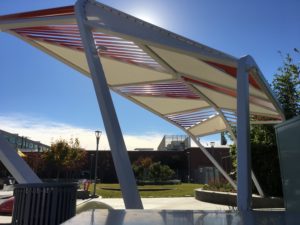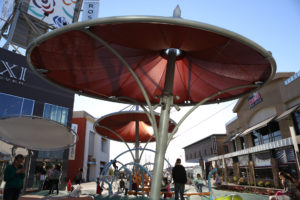You’ve decided that installing a tension structure on your property is the right move to make. Which tension structure fabric will you choose? Last week, we talked about a few different application scenarios. We talked about the best fabric for your needs.
It raised the question, “how many options does Tension Structures have for its customers?” We decided it would be timely to break down our available options.
Here is a summary of our variety of fabric choices:
PTFE (Teflon™) – Coated Fiberglass
 The strength to withstand up to 1,000 pounds per inch, the durability to hold up to extreme temperatures, and excellent fire rating qualities to boot. PTFE coated fiberglass is one of the strongest materials on the market. It does a fantastic job of enduring the test of time with its average 35-year lifespan. Depending on total thickness, you can expect a light transmission range between 12%-17%. This range makes it ideal for areas where you want to create a soft lighting environment.
The strength to withstand up to 1,000 pounds per inch, the durability to hold up to extreme temperatures, and excellent fire rating qualities to boot. PTFE coated fiberglass is one of the strongest materials on the market. It does a fantastic job of enduring the test of time with its average 35-year lifespan. Depending on total thickness, you can expect a light transmission range between 12%-17%. This range makes it ideal for areas where you want to create a soft lighting environment.
PTFE (Teflon™) – Coated Fiberglass Mesh
 With excellent durability and a noncombustible scrim, PTFE coated fiberglass mesh fabrics are an excellent choice for high rises and vertical building facades. The mesh weave adds a new use to the simpler PTFE coated fiberglass material. Mesh is great at providing shade yet porous enough to let air through. This means it can handle longer applications without having to withstand as much stress as some other fabrics might.
With excellent durability and a noncombustible scrim, PTFE coated fiberglass mesh fabrics are an excellent choice for high rises and vertical building facades. The mesh weave adds a new use to the simpler PTFE coated fiberglass material. Mesh is great at providing shade yet porous enough to let air through. This means it can handle longer applications without having to withstand as much stress as some other fabrics might.
TiO2 – Coated PTFE Membrane
 Perfect for high-traffic areas, which may also see disproportionate levels of air pollution, the TiO2 coated PTFE membrane is a material that actually cleans itself and the environment around it! Its special coating works by creating a chemical reaction when organic material like smog lands on its surface. This basically causes pollutants to decompose, and they quickly slide off the next time it rains. In other words, TiO2 coated PTFE membranes stay pearly white on their own.
Perfect for high-traffic areas, which may also see disproportionate levels of air pollution, the TiO2 coated PTFE membrane is a material that actually cleans itself and the environment around it! Its special coating works by creating a chemical reaction when organic material like smog lands on its surface. This basically causes pollutants to decompose, and they quickly slide off the next time it rains. In other words, TiO2 coated PTFE membranes stay pearly white on their own.
ePTFE with Fluoropolymer Coating
 Another low-maintenance fabric option is ePTFE with fluoropolymer coating. This material has a top layer that makes it extra slick. Nearly anything that falls on it will immediately slide off. This is an excellent choice if your property has a lot of leaves, snow, or anything else that would usually need to be cleaned off of a roof. This tension structure vastly cuts down on cleaning costs and stays beautiful year-round.
Another low-maintenance fabric option is ePTFE with fluoropolymer coating. This material has a top layer that makes it extra slick. Nearly anything that falls on it will immediately slide off. This is an excellent choice if your property has a lot of leaves, snow, or anything else that would usually need to be cleaned off of a roof. This tension structure vastly cuts down on cleaning costs and stays beautiful year-round.
Light-Weight PVC Membrane
 The quickest and easiest off-the-shelf option to install is the light-weight PVC membrane. Best used for shorter distance applications, this fabric is great for smaller tension structures. One of its best qualities is its cost. You don’t need special orders or premiums. This means that it’s readily available and can be sold by the yard.
The quickest and easiest off-the-shelf option to install is the light-weight PVC membrane. Best used for shorter distance applications, this fabric is great for smaller tension structures. One of its best qualities is its cost. You don’t need special orders or premiums. This means that it’s readily available and can be sold by the yard.
High-Strength PVC Membrane
 Probably the most commonly utilized building material when it comes to tension structures, high-strength PVC membranes are a cost-effective fabric that doesn’t compromise on durability. This material will generally last 10-15 years in high UV environments. The difference between a high-strength PVC membrane and its light-weight counterpart is mainly the distance that it is able to span, with the former being capable of stretching much further than the latter.
Probably the most commonly utilized building material when it comes to tension structures, high-strength PVC membranes are a cost-effective fabric that doesn’t compromise on durability. This material will generally last 10-15 years in high UV environments. The difference between a high-strength PVC membrane and its light-weight counterpart is mainly the distance that it is able to span, with the former being capable of stretching much further than the latter.
PVC Membrane Mesh Tension Structure Fabric
 Pairing the low cost and high availability of PVC membranes with the added air circulation of mesh fabric design, this is one material that’s a hybrid “best of both worlds” option for your next tension structure. PVC Membrane Mesh fabrics allow water to drip through, eliminating ponding. Additionally, the porosity also lets some wind come through and reduce the temperature of the air surrounding visitors without allowing it to become a nuisance. Think of it as a cool breeze machine.
Pairing the low cost and high availability of PVC membranes with the added air circulation of mesh fabric design, this is one material that’s a hybrid “best of both worlds” option for your next tension structure. PVC Membrane Mesh fabrics allow water to drip through, eliminating ponding. Additionally, the porosity also lets some wind come through and reduce the temperature of the air surrounding visitors without allowing it to become a nuisance. Think of it as a cool breeze machine.
High-Density Polyethylene (HDPE)
 Known around the industry as “shade cloth,” this fabric’s primary use is in its nickname. High-density Polyethylene is best used in environments where you need to create shade. The reason it does such an effective job of blocking sunlight is due to the way it’s made. While other fabrics are woven, HDPE is knitted. This means greater overlap of layers, creating a relatively inexpensive way to create artificial shade in many different situations.
Known around the industry as “shade cloth,” this fabric’s primary use is in its nickname. High-density Polyethylene is best used in environments where you need to create shade. The reason it does such an effective job of blocking sunlight is due to the way it’s made. While other fabrics are woven, HDPE is knitted. This means greater overlap of layers, creating a relatively inexpensive way to create artificial shade in many different situations.
Start Your Tension Structure Initiative
In the Tension Structures Division of Eide Industries, we specialize in the design, engineering, manufacturing, and installation of structurally complex and creatively challenging commercial, government, and prototype design projects. We provide expertise and support for architects, landscape designers, general contractors, and property owners to develop their custom tensile membrane project ideas and construct iconic structures.
Explore the tension structure fabric options for your next project. Contact one of our experts today by calling 800-422-6827.
